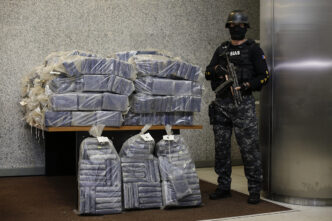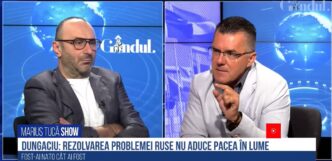No drug seizures have been detected in the Port of Constanța since 2021, according to information provided by the General Police Inspectorate to G4Media and Info Sud-Est, although the latest report on drugs at EU level, published in June by the European Monitoring Centre for Drugs and Drug Addiction (EMCDDA), shows that trafficking networks are increasingly targeting smaller EU ports.
Moreover, in a report produced in partnership with several European institutions, the DIICOT said that Romania is a transit country on the Balkan route (especially through seaports on the Black Sea), especially for drugs such as heroin, cocaine and ecstasy.
In total, from 2000 to date, authorities have seized only 20 tonnes of drugs in the port of Constanta, a Info Sud-Est analysis based on information obtained from the IGPR shows. By comparison, 70 tonnes of cocaine were seized in the Port of Rotterdam in 2021 alone, and in August 2023 customs officers seized 8 tonnes of cocaine in a single day. In Antwerp (Belgium) more than 110 tonnes of cocaine were seized in 2022 alone. Info Sud-Est presents the drug seizures in the Port of Constanța seized by the authorities over the last quarter of a century.
- DIICOT and the General Inspectorate of the Romanian Police did not respond to G4Media’s request for a comment by the time this article was published.
In 2000, customs officers at the Port of Constanța did not detect any drug shipments and in 2001 8.6 tonnes of hashish were seized. For 8 years the authorities did not detect any more grams of drugs in the port, until 2009 when 1.4 tonnes of cocaine were seized. Subsequently, customs officers found more drugs every 2 years and only a few kilograms: in 2011 – 160 kg of cocaine, in 2013 – 30 kg of cocaine, in 2015 – 2 tons of sodium salt of MDP2P glycidic acid (pre-precursor of high-risk drugs). In 2016, four more shipments were detected in the total amount of about 2.3 tons of cocaine.
For three years no more drugs were detected, and since 2019 there have been three years in which police officers have seized: 1.7 tonnes of cocaine, 1 tonne of captagon and 1.4 tonnes of hashish (2020) and 1.5 tonnes of cocaine (2021). For two years, no drug shipments have been detected in the Port of Constanta, according to IGPR information.
Read also ANALYSIS For corruption in the Port of Constanta, DNA has completed only one case with a prison sentence in the last 20 years / In other cases the courts have pronounced acquittals or suspended prison sentences.
Drug seizures in leaps and bounds are taking place in the Port of Constanta at a time when EU and DIICOT reports show a parallel reality, in contrast to the reality on the ground: drug trafficking networks are increasingly seeking smaller EU ports, and Romania is a transit country on the Balkan Route. Romanian seaports on the Black Sea (especially Constanța) are still seen by traffickers as a viable alternative for transporting drugs to the European Union, says the DIICOT report “Coordinated fight against new trends in drug trafficking – Snow White”, about which G4Media wrote extensively here.
In 2021, EU member states seized a record 303 tonnes of cocaine. Drugs seized in Belgium (96 tonnes), the Netherlands (72 tonnes) and Spain (49 tonnes) accounted for almost 75% of the total amount seized. According to preliminary data for 2022, the amount of cocaine caught in Antwerp, Europe’s second largest seaport, increased to 110 tonnes from 91 tonnes in 2021, the EU EMCDDA report shows. In 2021, Romania caught only 1.5 tonnes of cocaine. G4Media wrote extensively about the EU report’s findings here.
One of the Port of Constanța’s vulnerabilities is the understaffing of control institutions, which is all the more felt now that activity in the Port of Constanța has increased as a result of the war in Ukraine. “During the study visit, the Customs Service, which is arguably the stopgap force at the border, said it would need a 50 percent increase in its port staff to be effective. The Snow White report also notes that the Customs Service’s mobile scanning equipment was completely non-functional.
In the port of Constanța, the checks carried out by the Customs Service are rather bureaucratic, based on a risk analysis. The main indicators are: country of dispatch, consignor, or intermediate consignor, consignee, type of packaging, transport costs and/or description of goods. Where appropriate, the assessment should be coupled with a physical check, such as an X-ray scan.
However, there are only two X-ray scanners in the whole port and the Customs Service does not have a functioning scanner in its equipment. Although it has a mobile scanner, it has been inoperative since 2016 due to lack of authorisation and is due to be scrapped. The X-ray scanner currently operating at BVF Constanta Sud has been provided by the Constanța Port Administration. By August this year, 1377 containers had been scanned in this way, but no irregularities were found, according to a response from the authority sent to Info Sud-Est.
DP World will inaugurate this autumn an x-ray scanner in the container terminal at the Port of Constanța, which it has been operating since 2003. The investment amounts to €15 million and the screening equipment will be operated by the port authorities. Only two other scanners still operate in the port, one operated by the customs office and the other by the police. Details, on G4Media.
Ne bucurăm că ne citești!
Dacă vrei să ne și susții:











